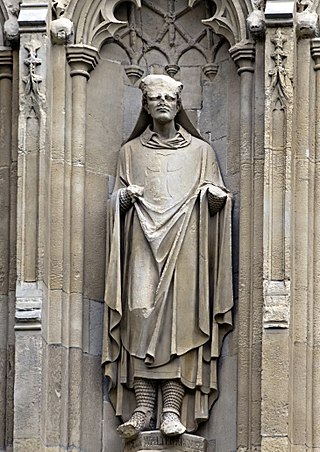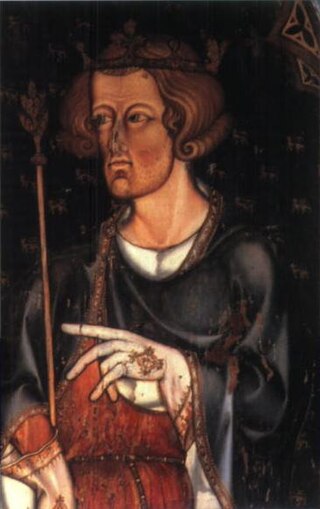
Hubert Walter was an influential royal adviser in the late twelfth and early thirteenth centuries in the positions of Chief Justiciar of England, Archbishop of Canterbury, and Lord Chancellor. As chancellor, Walter began the keeping of the Charter Roll, a record of all charters issued by the chancery. Walter was not noted for his holiness in life or learning, but historians have judged him one of the most outstanding government ministers in English history.
Ranulf de Glanvill was Chief Justiciar of England during the reign of King Henry II (1154–89) and was the probable author of Tractatus de legibus et consuetudinibus regni Anglie, the earliest treatise on the laws of England.
William of Poitiers was a Frankish priest of Norman origin and chaplain of Duke William of Normandy, for whom he chronicled the Norman Conquest of England in his Gesta Willelmi ducis Normannorum et regis Anglorum or Gesta Guillelmi II ducis Normannorum. He had trained as a soldier before taking holy orders.

The Statutes of Mortmain were two enactments, in 1279 and 1290, passed in the reign of Edward I of England, aimed at preserving the kingdom's revenues by preventing land from passing into the possession of the Church. Possession of property by a corporation, such as the Church, was known as mortmain, which literally meant "dead hand". In medieval England, feudal estates generated taxes for the King, principally on the grant or inheritance of the estate. If an estate became owned by a religious corporation which could never die, could never attain majority, and could never be attainted for treason, these taxes never became payable. It was akin to the estates being owned by the dead, hence the term.
In old English law, an essoin is an excuse for nonappearance in court. Essoining is the seeking of the same. The person sent to deliver the excuse to the court is an essoiner or essoineur.
The legal term peace, sometimes king's peace or queen's peace, is the common-law concept of the maintenance of public order.

Anglo-Saxon law is a body of written rules and customs that were in place during the Anglo-Saxon period in England, before the Norman conquest. This body of law, along with early Medieval Scandinavian law and Germanic law, descended from a family of ancient Germanic custom and legal thought. However, Anglo-Saxon law codes are distinct from other early Germanic legal statements—known as the leges barbarorum, in part because they were written in Old English instead of in Latin. The laws of the Anglo-Saxons were the second in medieval Western Europe after those of the Irish to be expressed in a language other than Latin.
In tort law, detinue is an action to recover for the wrongful taking of personal property. It is initiated by an individual who claims to have a greater right to their immediate possession than the current possessor. For an action in detinue to succeed, a claimant must first prove that he had better right to possession of the chattel than the defendant, and second, that the defendant refused to return the chattel once demanded by the claimant.

Henry of Bracton, also Henry de Bracton, also Henricus Bracton, or Henry Bratton also Henry Bretton was an English cleric and jurist.

Quia Emptores is a statute passed by the Parliament of England in 1290 during the reign of Edward I that prevented tenants from alienating their lands to others by subinfeudation, instead requiring all tenants who wished to alienate their land to do so by substitution. The statute, along with its companion statute Quo Warranto also passed in 1290, was intended to remedy land ownership disputes and consequent financial difficulties that had resulted from the decline of the traditional feudal system in England during the High Middle Ages. The name Quia Emptores derives from the first two words of the statute in its original mediaeval Latin, which can be translated as "because the buyers". Its long title is A Statute of our Lord The King, concerning the Selling and Buying of Land. It is also cited as the Statute of Westminster III, one of many English and British statutes with that title.
Plea rolls are parchment rolls recording details of legal suits or actions in a court of law in England.

The title Leges Edwardi Confessoris, or Laws of Edward the Confessor, refers to a collection of laws, purporting to represent English law in the time of Edward the Confessor, as recited to the Norman invader king William I in 1070, but which was not composed until probably the early years of the reign of King Stephen.
The Leges Henrici Primi or Laws of Henry I is a legal treatise, written in about 1115, that records the legal customs of medieval England in the reign of King Henry I of England. Although it is not an official document, it was written by someone apparently associated with the royal administration. It lists and explains the laws, and includes explanations of how to conduct legal proceedings. Although its title implies that these laws were issued by King Henry, it lists laws issued by earlier monarchs that were still in force in Henry's reign; the only law of Henry that is included is the coronation charter he issued at the start of his reign. It covers a diverse range of subjects, including ecclesiastical cases, treason, murder, theft, feuds, assessment of danegeld, and the amounts of judicial fines.

The Regiam Majestatem is the earliest surviving work giving a comprehensive digest of the Law of Scotland. The name of the document is derived from its first two words. It consists of four books, treating (1) civil actions and jurisdictions, (2) judgments and executions, (3) contracts, and (4) crimes.

The Tractatus de legibus et consuetudinibus regni Angliae, often called Glanvill treatise, is the earliest treatise on English law. Attributed to Ranulf de Glanvill and dated 1187–1189, it was revolutionary in its systematic codification that defined legal process and introduced writs, innovations that have survived to the present day. It is considered a book of authority in English common law.

Hugh Bardulf or Hugh Bardolf was a medieval English administrator and royal justice. Known for his legal expertise, he also served as a financial administrator. He served three kings of England before his death.
The first signs of the modern distinction between criminal and civil proceedings were during the Norman conquest of England in 1066. The earliest criminal trials had very little, if any, settled law to apply. However, the civil delictual law was highly developed and consistent in its operation.
Caput lupinum or caput gerat lupinum are terms used in the English legal system and its derivatives. The terms were used in Medieval England to designate a person pronounced by the authorities to be a dangerous criminal, who could thus be killed without penalty.
Osbert fitzHervey was an Anglo-Norman royal judge. Brother of Hubert Walter and Theobald Walter, Osbert served three kings of England and may have contributed to the legal treatise attributed to his uncle, Ranulf de Glanvill. Ralph of Coggeshall, a medieval writer, praised Osbert's knowledge of law, but condemned his acceptance of gifts from plaintiffs and defendants in legal cases. Osbert was one of a group of men who are considered the first signs of a professional judiciary in England.
William the Conqueror, the first Norman King of England who reigned from 1066 until his death in 1087, created 10 laws for the English people to abide by after the Battle of Hastings.









